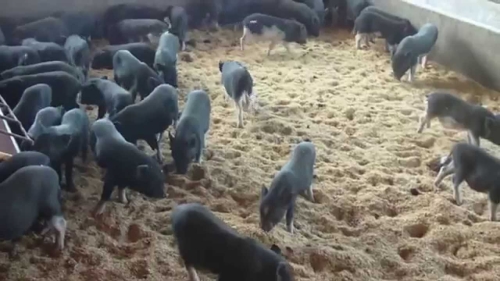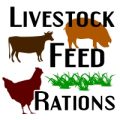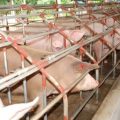A native pig project in Bondoc Peninsula succeeds in raising income of farmers by P33,700 in two years just from selling piglets and opens bigger opportunities for them to sell the specialty “Lechon.”

The Food and Agriculture Organization (FAO) is replicating the success of this native pigs multiplier project funded by the Bureau of Agricultural Research (BAR). It is implemented by the University of the Philippines Los Banos (UPLB) Agricultural Systems Cluster-College of Agriculture.
It is in two barangays located in two municipalities in Bondoc Peninsula, Quezon—Brgy. Latangan of Mulanay and Brgy. San Juan of San Narciso.
Rural farmers’ income there traditionally reaches to only P5,000 to P6,000 yearly according to ipon-philippines.org.
That is being raised by the Native Swine Project (NSP) by two to three times .
“A farmer with two sows, each producing seven weanlings three times in two years will have added income of P33,700 from piglet sales alone,” said Dr. Mary Jean G. Bulatao, UPLB Native Swine Project (NSP) team leader.
BAR is committed to implementing Phase 2 which expands the program to Real and Infanta, also in Quezon. The first phase was implemented from July 2009 to October 2011.
“We want to raise livelihood opportunities in these mostly upland areas. Their increased production of native hogs will also enable them to meet a requirement for a specialty product that has a growing market in Metro Manila,” said BAR Director Nicomedes P. Eleazar.
Dos por Cinco
The native swine project’s production and repayment scheme have worked well in the selected Bondoc Peninsula communities.
Each farmer-beneficiary received two ready-to-breed gilts (the Dos part). This enabled farmers to have a year-round supply of piglets.
As observed in the community, a native sow normally farrows or gives birth to piglets two times in 14 months. This produces an average of 28 piglets.
The project also provided five weanlings or piglets (the Cinco part) to farmers for immediate fattening. This should generate cash to farmers in three to four months.
That’s cash while they are waiting for the gilts (young female pig) to produce piglets.
Hardwork
Dos por Cinco is not just a dole out system that is here today and gone tomorrow. It encourages farmers to work hard by contributing something to it. That is land, at least a 1,000 square meters (sq.m), and labor.
They had to plant their farms with feed resources (such as Gabing san fernando, madre de agua, and some herbal plants for supplements. A main feed resource is the Gabing San Fernando (GSF).
GSF corm is reported by UPLB Researcher Virgilio T. Villancio to be capable of substituting corn by 60 to 90 percent as the feed ingredient’s energy source.
Farmers also had to grow GSF and Trichantera or madre de agua. They had to construct a simple animal shed to protect animals from harsh environment. They had to care for the animals, put up fences in order to block stray animals from destroying the farm.
GSF corm is a tubelike portion of the GSF’s stembase and forms part of the main root system. It is also used as a planting material. It is locally called “sakwa” or “bungo” in Bondoc Peninsula.
“The project promoted the use of sakwa (a by-product) as the main source of energy feed for ranging native swine to improve nutrient availability and increase the average daily gain of the animals,” said Bulatao.
Profitable
Native pig business can be profitable.
For a 25-kilo pig, a farmer can enjoy a P780 income per head. If a farmer decides to raise five heads in one cycle (five to six months), or a total of 10 heads per year, he will have an added income of P7,800 yearly.
Based on the project’s data, native sows can produce an average of seven live piglets in a litter. A farmer with two sows producing seven weanlings each, two times in 14 months , can have an added income of about P22,484 in 14 months or about P33,700 per two years from piglets alone.
“These may be modest added returns but very important to the farmers. These become a significant buffer income in times of unexpected needs. Farmers are now starting to treat this activity as a business enterprise,” said Bulatao.
Weight gain
The improvement in the quality of feeds given by the farmers to their native pigs from farmers’ own feed garden raised the average daily gain (ADG) of the native pigs.
The farmers were encouraged that they can earn higher from the GSF feeding. And that is without changing much of their traditional pig growing practices.
ADG for San Narciso was 0.13 kilos and Mulanay, 0.12 kilos. That is a significant improvement of at least 33 percent from their previous 0.09 kilos daily weight gain. Slaughter weight of animals is 15 to 30 kilos.
Higher ADG cut the fattening period of a 21-kilo pig by one month. That’s an important opportunity to turn money around over a shorter time.
Paying back
Farmers pay for the Dos por Cinco gilts and fattening weanlings by giving back piglets.
They are considered debt-free once they give back the number of piglets whose price is equal to the purchase cost of the loaned animals.
Their piglet payments become part of a multiplier program. These are re-loaned to other organization members.
At the start, the project had 12 farmer partners—six in each of the barangay pilot areas. Beneficiaries are now at least 45 including the original 12 farmers, (as of this May 2013 at least 54 farmers), a 300 percent growth!
In two years, animal inventory of the farmers increased by 50 to 100 percent, while household income was up by 50 percent. Repayment is placed at 80 percent.
Because authorities saw how the NSP beneficiaries multiplied fast with good repayment rate, the FAO-International Labor Organization Livelihood Project adapted the Dos por Cinco scheme.
It operates in the same area. It provided the Dos por Cinco package or module to an additional 35 RIC (Rural Improvement Club) members in the Mulanay site.
The pig module (with two gilts, five weanlings) per farmer costs around P15,000.
Moreover, the local government of San Narciso also released some funds to benefit an additional three to five farmers initially.
GSF is now a valued feed product with its cormlet as food and sakwa as feed. Sakwa for native swine feed is now sold at P120 per sack in the market. It was only thought as waste before and given away free-of-charge.
Value adding
Phase 2 is stepping up help to farmers by providing options in marketing.
The first is on value adding, particularly meat processing. It involves producing finished products like sausage, longganiza, or cut-up pork that will give them an even higher income.
A freezer and other basic equipment like vacuum packaging machine, meat grinder, and some tools will be provided to the organization .
Good Agricultural Practice and Good Manufacturing Practice will be observed to assure clean and safe meat for consumers.
The other choice is for the farmer organization to become an assembler or consolidator. It involves gathering the animals from individual farmer members and selling in bulk to the assemblers-truckers. They themselves may also transport the animals to Metro Manila, acting as an assembler-trucker .
But they need to be able to gather at least 200 animals at a single time for the transport to be cost efficient.
These programs will channel to farmers a portion of the income that goes to assemblers, `traders-transporters-.
At present, the link between farmers and lechon processors are the traders.
But in the future there is a plan to link the Bondoc Peninsula native pig producers (as an organization) to other processors and lechon retail chains. This will market their hogs not only to Metro Manila but also to nearby urban centers like the cities of Lucena, San Pablo and Lipa.
Smaller margin
Farmers’ direct contact to market will raise their income. At present, they are losing income opportunities that normally go to middlemen or traders.
“The animals have to pass through the village agent then to the municipal agent-assembler before they are loaded for delivery to the lechon processor by the trucker-assembler,” she said.
For instance, for a small 17-kilo or less live pig , a farmer receives a farmgate price of P1,000. The agent resells this at P1,200. Then the trucker resells it at P1,600. The lechon processor sells at P2,244.
Healthy
It has been a tradition for coconut farmer sin Bondoc Peninsula to raise native pigs. They sell these for full sized lechon or for “Lechon de Leche,” a roasted pig in its tender meat and crispy skin.
Its preferable taste compared to commercial breeds may be attributed to the native breed. The flavor of native lechon is also attributed to the production system.
Being raised free-range (roaming under coconut trees), the pigs become lean from the daily exercise and are able to access vegetation in the area.
Other herbs
The animals need other feed ingredients like the Trichantera gigantea as protein source.
The native pigs’ feed is a combination of two or three of different feed ingredients that are boiled together.
The choices are GSF corm, gabi tubers, gabi leaves and trunks, rice and corn bran, matured coconut meat, cassava, banana trunk, market wastes, kitchen refuse, kangkong, papaya, oraro rejects, malunggay, mixed vegetable refuse, ipil-ipil, sweet potato leaves, Trichantera or Madre de Agua.
Boars and lactating sows are given rice or corn bran added into cooked feed.
Feeding is two times a day.
Breeding program
The ongoing Phase 2 will also involve breeding. It has a partnership with the Bureau of Animal Industry (BAI)-National Swine and Poultry Research and Development Center based in Tiaong, Quezon. BAI is engaged in a study on “Animal Genomics to Increase Productivity
Part of the BAI-NSPRDC project is to characterize and conserve the Philippine native pigs. .
Bulatao said this is of the essence.
“While native pigs are considered disease resistant compared to commercial breed, the project still encountered mortality due to disease,” she said.
Native pigs, unlike the imported white breeds, are usually colored black or have spots.
Production
As of July 2011, the San Narciso site produced a total of 173 animals. These were 15 breeders, 110 weaners, and 48 piglets. The Mulanay site produced 189 animals. These were 15 breeders, 128 weaners, and 46 piglets.
After six-seven months of planting GSF, farmers’ fields yielded an average of 240 kilos of fresh GSF tuber per 1,000 sq.m.(2.4 tons per hectare).
In Brgy. San Narciso, after seven months, farmers produced 2.2 tons per hectare of sakwa; 2.4 tons per hectare of gabi; and 7.6 tons per hectare of herbage)
In Brgy. Mulanay, after six months, farmers produced 390 kilos of sakwa per 1,000 sq.m., 6,420 kilos of gabi over the same area, and 760 kilos of herbage.
San Narciso farmers sold their pigs at P94 per kilo of live weight while Mulanay, at P90 per kilo.
Weanlings were priced P800 to P1,000 per head.
Average farm gate price of native pigs per head was P2,161 for Mulanay for an average weight of 24.49 kilos and P1,787 per head for San Narciso for an average weight of 19.03 kilos.
Bondoc Peninsula
The farmers in the pilot program in Brgy. Latangan, Mulanay came from the Rural Improvement Club (RIC), a women’s group supported by the town local government unit. A total of 22 out of 43 RIC members became partners at the end of two years.
“The number is continuously growing as other members await their turns to receive five heads of native swine,” said Bulatao.
In San Narciso, the farmers already formed a group– San Juan Native Swine Producers Association.
Farmers underwent training and visited the National Swine and Poultry Research and Development Center in Tiaong, Quezon and the Animal and Dairy Sciences Cluster Farm in UP Los Banos.
They were trained on Good Agricultural Practices to improve their native pig production practices including prevention and management of common swine diseases. It also included preparation of common herbal supplements to improve animal health and reduce mortality.
They were also taught on record keeping and financial management.
###
For any questions, please call Dr. Mary Jean G. Bulatao, UPLB-CA; for interview requests, Ms. Analiza C. Mendoza, 0923-436-3177







Native pig business can be profitable.
For a 25-kilo pig, a farmer can enjoy a P780 income per head. If a farmer decides to raise five heads in one cycle (five to six months), or a total of 10 heads per year, he will have an added income of P7,800 yearly.
Based on the project’s data, native sows can produce an average of seven live piglets in a litter. A farmer with two sows producing seven weanlings each, two times in 14 months , can have an added income of about P22,484 in 14 months or about P33,700 per two years from piglets alone.
Read more at BusinessDiary.com.ph: http://businessdiary.com.ph/5680/bondoc-peninsula-native-pigs-project-raises-farmers-income-to-p33700-in-two-years-opens-opportunities-to-bigger-specialty-lechon-market/#ixzz4DW8QhOIi
2800 lang kita mo per MONTH????
HOPEFULLY MAGSTART KAMI NG PROJECT NA NATIVE PIG IN MARAHAN DAVAO CITY
napakaganda ang proyekto po…ipagpatuloy po ninyo iyan
It looks like this project is not viable in a corporate style farming where labor and utilities are paid. In my case, one laborer is paid 4000 monthly including rice allowance or 96k in two years . Even if you charge only half for labor as the laborer is given other farm tasks, that's still 48k which is more than expected revenues in two years. I can probably get better market price due proximity to market but still not enticing. Pwede mag alaga for own lechon consumption.
Add a comment.mahirap magbenta ng native pig walang market isaisa lang kung bilihin
marami ako nyan..
Add a comment…
selling native pigs 09164432435